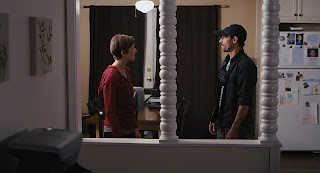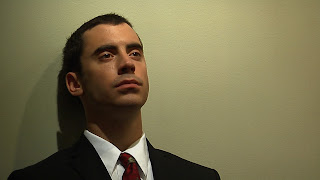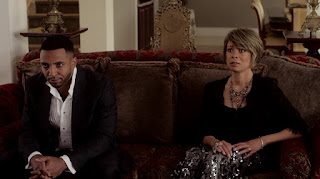DVD Review - The Happy Sad
You probably don't know about this film unless you follow Rodney Evans on Twitter or Facebook, or you're perhaps a student at Temple University where Evans is a professor, or you just happened to be in New York City or Los Angeles for the week in August 2013 when this film hit theaters. The Happy Sad also played at various LGBT festivals, which seems to attract its target audience, but this film is more mainstream than that. The Happy Sad is not simply for gay people. Aside from two men kissing and two women kissing, the only sex actually depicted is between a man and a woman, and even that has specific purpose. The rest is all talk, which makes sense given it's an adaptation of Ken Urban's stage play.
The tale revolves around two couples living in Brooklyn. One is a gay male couple. The other is a straight couple. Marcus and Aaron live together after having been dating for six years. Stan and Annie don't live together because they've only been dating for six months. Both couples had no clue of the other's existence until on the same day both decide to drastically change the direction of their relationships, leading members of both couples to have affairs with other people.
For Stan and Annie, it all begins when Annie announces to Stan that she wants to separate. Stan suspects that she's met someone else. When he presses her for an answer, she lies and says she's having a lesbian affair with fellow teacher Mandy. At the time, she couldn't tell him the real reason, which is she's turned off by his struggling musician status that isn't really going anywhere.
Yet, Annie's lie was a Freudian slip because she does launch into an actual lesbian affair with Mandy. Perhaps, Annie's separation from Stan was due to the underlying homosexual tendencies in her, which then recognized the same in Stan because with no introduction Stan is shown having sex with another man.
For Marcus and Aaron, it also begins on the same day as Stan and Annie's separation. The previous night, they had a threesome, which prompts Marcus to remark his interest in seeing Aaron being with another guy. This prompts Aaron to suggest an open relationship. Both tentatively agree but they come up with one simple rule. It gets to a point though that Aaron becomes afraid that Marcus will break that rule, which unfortunately he does.
The problem is that the two have been together for six years. Aaron is 23 and Marcus can't be that much older, which means they've been a couple since they were teenagers. This also implies that they were probably each others' firsts and though monogamous never experienced any others or dated anyone else, which could have left a question or curiosity in their minds.
During a train ride, Aaron who is an aspiring actor admits that during a play, he had to be someone's boyfriend and he got confused about things. His reaction to a rash on his body speaks to his naivety about certain experiences, even interpersonal ones.
Marcus and Aaron embark on their explorations. They continue living and loving one another. It's simply on occasion they have sex with other men. Stan and Annie embark on their explorations. There is no indication if up until this point either had considered any fluctuations as to where they were on the Kinsey scale, but either starts having same-sex relations. Once the two couples reach a breaking point, decisions are made that yield surprising results. The idea of an open relationship isn't condemned. Neither is the idea of shifting sexuality.
Urban's play under Evans' direction brushes aside those barriers. For some, love is still a restrictive thing, limited by walls like monogamy or even sexual orientation. This movie knocks those walls down and let's the notion of love be restricted by nothing as to allow a deeper discovery and investigation of what's going on with these couples.
All of this is not to say that homophobia isn't an issue. It's just barely there. Unlike Evans' previous film Brother to Brother, now almost 10 years ago, the homophobia isn't purely external. Here, it's internalized. It marks quite a change in Evans to see his depiction of black gay love then and now. In Brother to Brother, his central character, as a young, black, gay man would never walk hand-in-hand with another through the streets of Harlem or Brooklyn. Here, Marcus and Aaron do it with aplomb.
There is also a certain aplomb to Evans' direction. It's definitely not as showy as in his previous feature, which needed it. Here, Evans knows he doesn't need it. Any artifice is not present. Wardrobe is minimal, it appears. So is makeup. It's just a natural beauty that shines through. I would venture a lot of natural lighting as well, putting the players in a more authentic, if not starker view, allowing the purity of what's happening to be the only thing to shine, the purity of the four main actors.
Leroy McClain as Marcus shines a love and tenderness, rarely shown by or for black men. Charlie Barnett as Aaron shines a naivety and fear that is endearing as much as it is melting. Cameron Scoggins as Stan shines a vulnerability and confusion that perhaps isn't new but it resonates so genuinely from Scoggins. Sorel Carradine as Annie shines an anxiety and eventual acceptance, as well as evolution on screen that's simply refreshing.
For Evans, there is an evolution too. It's as simple as the choice of music in this film as compared to the last. The jazz music in Brother to Brother spoke to a history, a foundation. Yet, the alternative rock music here as well as various other music choices are less historical. They're progressive, just as this movie is progressive.
Five Stars out of Five.
Not Rated but recommended for mature audiences.
Running Time: 1 hr. and 27 mins.
The tale revolves around two couples living in Brooklyn. One is a gay male couple. The other is a straight couple. Marcus and Aaron live together after having been dating for six years. Stan and Annie don't live together because they've only been dating for six months. Both couples had no clue of the other's existence until on the same day both decide to drastically change the direction of their relationships, leading members of both couples to have affairs with other people.
For Stan and Annie, it all begins when Annie announces to Stan that she wants to separate. Stan suspects that she's met someone else. When he presses her for an answer, she lies and says she's having a lesbian affair with fellow teacher Mandy. At the time, she couldn't tell him the real reason, which is she's turned off by his struggling musician status that isn't really going anywhere.
Yet, Annie's lie was a Freudian slip because she does launch into an actual lesbian affair with Mandy. Perhaps, Annie's separation from Stan was due to the underlying homosexual tendencies in her, which then recognized the same in Stan because with no introduction Stan is shown having sex with another man.
For Marcus and Aaron, it also begins on the same day as Stan and Annie's separation. The previous night, they had a threesome, which prompts Marcus to remark his interest in seeing Aaron being with another guy. This prompts Aaron to suggest an open relationship. Both tentatively agree but they come up with one simple rule. It gets to a point though that Aaron becomes afraid that Marcus will break that rule, which unfortunately he does.
The problem is that the two have been together for six years. Aaron is 23 and Marcus can't be that much older, which means they've been a couple since they were teenagers. This also implies that they were probably each others' firsts and though monogamous never experienced any others or dated anyone else, which could have left a question or curiosity in their minds.
During a train ride, Aaron who is an aspiring actor admits that during a play, he had to be someone's boyfriend and he got confused about things. His reaction to a rash on his body speaks to his naivety about certain experiences, even interpersonal ones.
Marcus and Aaron embark on their explorations. They continue living and loving one another. It's simply on occasion they have sex with other men. Stan and Annie embark on their explorations. There is no indication if up until this point either had considered any fluctuations as to where they were on the Kinsey scale, but either starts having same-sex relations. Once the two couples reach a breaking point, decisions are made that yield surprising results. The idea of an open relationship isn't condemned. Neither is the idea of shifting sexuality.
Urban's play under Evans' direction brushes aside those barriers. For some, love is still a restrictive thing, limited by walls like monogamy or even sexual orientation. This movie knocks those walls down and let's the notion of love be restricted by nothing as to allow a deeper discovery and investigation of what's going on with these couples.
All of this is not to say that homophobia isn't an issue. It's just barely there. Unlike Evans' previous film Brother to Brother, now almost 10 years ago, the homophobia isn't purely external. Here, it's internalized. It marks quite a change in Evans to see his depiction of black gay love then and now. In Brother to Brother, his central character, as a young, black, gay man would never walk hand-in-hand with another through the streets of Harlem or Brooklyn. Here, Marcus and Aaron do it with aplomb.
There is also a certain aplomb to Evans' direction. It's definitely not as showy as in his previous feature, which needed it. Here, Evans knows he doesn't need it. Any artifice is not present. Wardrobe is minimal, it appears. So is makeup. It's just a natural beauty that shines through. I would venture a lot of natural lighting as well, putting the players in a more authentic, if not starker view, allowing the purity of what's happening to be the only thing to shine, the purity of the four main actors.
Leroy McClain as Marcus shines a love and tenderness, rarely shown by or for black men. Charlie Barnett as Aaron shines a naivety and fear that is endearing as much as it is melting. Cameron Scoggins as Stan shines a vulnerability and confusion that perhaps isn't new but it resonates so genuinely from Scoggins. Sorel Carradine as Annie shines an anxiety and eventual acceptance, as well as evolution on screen that's simply refreshing.
For Evans, there is an evolution too. It's as simple as the choice of music in this film as compared to the last. The jazz music in Brother to Brother spoke to a history, a foundation. Yet, the alternative rock music here as well as various other music choices are less historical. They're progressive, just as this movie is progressive.
Five Stars out of Five.
Not Rated but recommended for mature audiences.
Running Time: 1 hr. and 27 mins.











Comments
Post a Comment